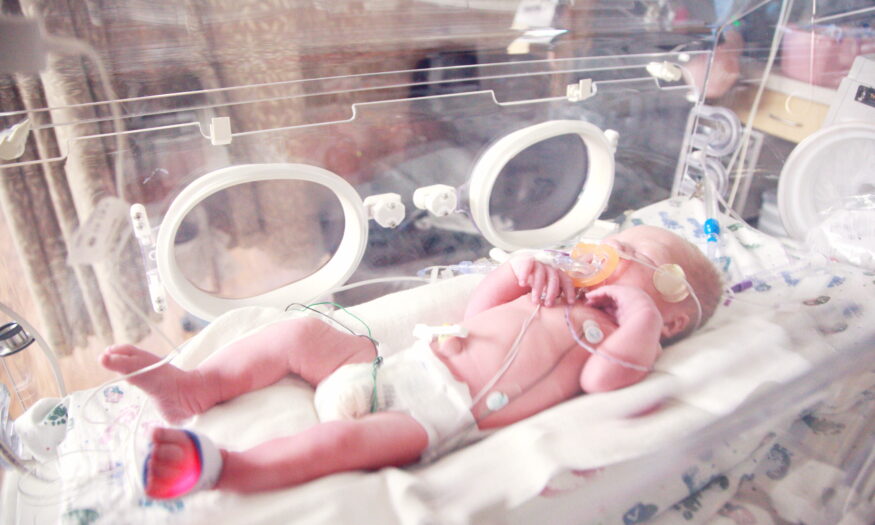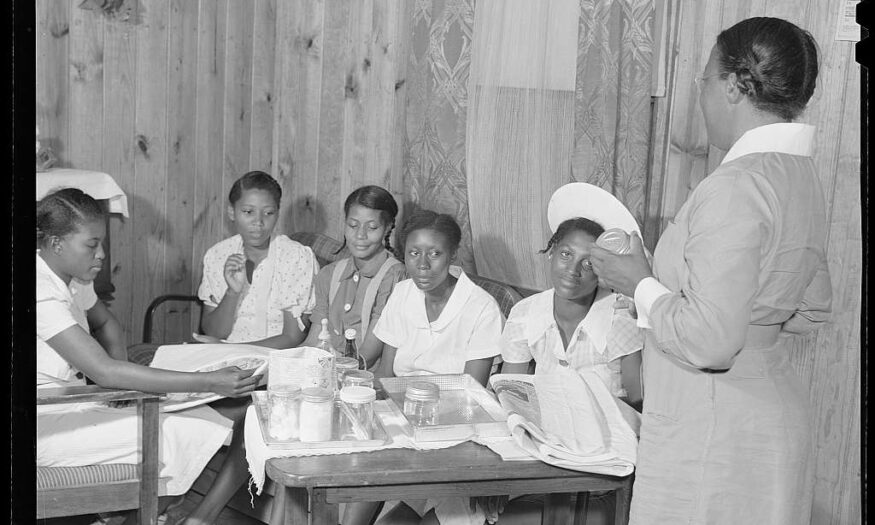The History of Midwifery
 Rebekah Vos/Unsplash
Rebekah Vos/Unsplash
-
Topics Include:
Birth
Birth Care Options
Doulas
History
Pregnancy
by Judith P. Rooks, CNM, MPH, MS, originally published May 30, 2012
edited by Our Bodies Ourselves Today, August 2022
In the United States, most births – more than 98 percent – take place in hospitals, with physicians, mainly obstetricians, attending.
But in many other wealthy industrialized countries, including the United Kingdom, Sweden, and Japan, midwives attend most births and far outnumber obstetricians. The difference has its roots in history. Midwives attended almost all births in the American colonies, practicing from their homes and passing the skills they had brought from Britain from one woman to another informally. West African midwives who were kidnapped and enslaved in the US attended the births of both Black and white women in the antebellum South. After emancipation, African American midwives continued to take care of both Black and poor white women in most rural parts of the South, where they were referred to as “granny midwives.” Indigenous peoples in what came to be the United States had their own diverse birth traditions.
Unlike in Europe and the British Isles, where midwifery laws were national, in early American history, midwifery laws were local and varied widely. With few midwifery schools, laws requiring education couldn’t be enforced; with few doctors geographically close enough, or willing, to attend poor women, it wasn’t practical to outlaw midwives. Midwives in most states practiced without government control until the 1920s. Even today, regulation of midwifery varies widely from state to state.
Medicine did not become professionalized in the U.S. until the last half of the 1800s. By the beginning of the 20th century, midwives attended only about half of all births in the U.S., and physicians attended the other half.
A series of events between 1910 and 1920 set the stage for doctors to usurp the traditional role of the midwife and laid the foundation for a pathology-oriented medical model of childbirth in this country. The 1910 Flexner Report, a book-length study of US medical education, had a transformative impact on midwifery. The report laid out a roadmap which, in addition to providing a profoundly racist, sexist, and classist blueprint for medical education, rightly concluded that America’s obstetricians were poorly trained. One recommendation was hospitalization for all deliveries and the gradual abolition of midwifery. Rather than consult with midwives, the report argued, poor women should attend charity hospitals, which would serve as sites for training doctors.
Just two years later, in 1914, “twilight sleep” was introduced. Twilight sleep was induced through a combination of morphine, for relief of pain, and scopolamine, an amnesiac that caused women to have no memories of giving birth. Upper-class women initially welcomed it as a symbol of medical progress, although its negative effects were later publicized.
In 1915, Dr. Joseph DeLee, author of the most important obstetric textbook of that period, described childbirth as a pathologic process that damages both mothers and babies “often and much.” He said that if birth were properly viewed as a destructive pathology rather than as a normal function, “the midwife would be impossible even of mention.” In the first issue of the American Journal of Obstetrics and Gynecology, DeLee proposed a sequence of interventions designed to save women from the “evils natural to labor.” The interventions included routine use of sedatives, ether, episiotomies, and forceps (all of which we now know to be harmful when used routinely).
DeLee was a very influential obstetrician who served as head of obstetrics at Northwestern University medical school and chairman of obstetrics and gynecology at the University of Chicago medical school. He changed the focus of health care during labor and delivery from responding to problems as they arose to preventing problems through routine use of interventions to control the course of labor. This change led to medical interventions being applied not just to the relatively small number of women who had a diagnosed problem, but instead to every woman in labor.
Obstetricians like DeLee and others who followed him helped reduce use of midwives by arrogantly arguing that midwives were untrained and incompetent, that pregnancy is a dangerous condition requiring care available only from highly trained medical specialists, and that midwives’ clients—mainly poor women—were needed to provide the clinical experience for training doctors in obstetrics.
Midwives attended approximately half of all births in 1900, but less than 15 percent by 1935. By the early 1930s most practicing midwives were Black or poor-white granny midwives working in the south. Where midwifery declined, the incidence of mother and infant deaths from childbearing or birth injuries generally increased. There was a 41 percent increase in infant mortality due to birth injuries between 1915 and 1929; this increase in infant mortality was primarily due to obstetrical interference in birth.
American obstetrics is still functioning under the medical paradigm of childbirth it inherited from Dr. DeLee. Other wealthy, industrialized countries have national health services, in which elements of care that aren’t needed and don’t bring improved health tend to be dropped because of the cost. In the U.S.’s for-profit health care industry, doctors often make more money with each intervention they perform (as do hospitals). This creates incentives for greater medical intervention and discourages low-intervention births that may take longer but be better for mothers and babies.
Nurse-Midwifery
Midwifery began a slow rebirth in the United States in the form of nurse-midwifery, when the Frontier Nursing Service (FNS) was founded in a poor, rural county in Kentucky in 1925. FNS was founded by Mary Breckinridge, who worked as a public health nurse for the Red Cross in France at the end of World War I. While overseas, she encountered British nurse-midwives, who had the combination of training she considered needed to help poor families in Kentucky.
Nurse-midwives attended only home births until the mid-1950s, when obstetric leaders of several inner-city teaching hospitals developed midwifery services within their departments to help them deal with the post-war “baby boom” and to improve the quality of care in those hospitals. Nurse-midwives did not veer from care of the poor for almost 50 years. By the early 1960s—nearly 40 years after the FNS was started—fewer than 70 nurse-midwives were in practice in the U.S.
Despite their small numbers, nurse-midwives were influential. They introduced the concept of family-centered maternity care (including the radical idea of allowing fathers in the delivery room), played a significant role in the development of childbirth education, demonstrated the concept of mother-baby rooming in (staying in the same room, rather than having the baby put in a separate nursery), and urged mothers to breastfeed at a time when most hospitals were teaching them how to make formula and sterilize bottles. Studies, then as now, documented cost savings and good outcomes from nurse-midwifery care. But it took social change and patient demand to begin to broaden the nurse-midwives’ role in the 1960s and 1970s.
In the US today, certified nurse-midwives work in the obstetric departments of hospitals. The desire to practice midwifery care unimpeded and avoid routine use of medical interventions motivated midwives to develop freestanding (non-hospital) birth centers. The first freestanding birth center opened in New York in 1975; today there are 384 freestanding birth centers in the United States in 37 states and Washington D.C.
The proportion of all U.S. births attended by certified nurse-midwives and certified midwives has increased from only about one percent in the mid-1970s to approximately ten percent of all hospital births in 2020 and 15 percent of all vaginal births in hospitals (excluding deliveries by cesarean section). In 2019 (the last year with available data), almost 95 percent of births attended by CNMs occurred in hospitals; the rest were home births and births in freestanding births centers.
Direct-Entry Midwives
A new form of midwifery developed during the 1960s and 1970s as part of women’s wider effort to claim power over their own bodies and births as part of the women’s movement. A small number of mostly well-educated, middle-class, white women started choosing to have home births with informally trained “lay” midwives, who are now more often referred to as direct-entry midwives.
“Direct-entry” means that the midwife entered midwifery “directly,” not through nursing; it is the predominant and preferred model in a number of countries. Some direct-entry midwives in the U.S. are associated with religious traditions such as the Amish, Mormons, and other Christian and Muslim groups.
A growing proportion of direct-entry midwives have completed a two-to-three-year midwifery curriculum designed to provide the knowledge and manual and critical-thinking skills required for safe care of mothers and their fetuses and babies during low-risk births in out-of-hospital settings. Most direct-entry midwives, however, do not have this formal midwifery education. Some have dedicated themselves to acquiring the necessary competencies and are well-prepared, vigilant, excellent midwives. And some excellent training programs have developed in recent decades. But, lacking enforceable standards for referring to oneself as a “midwife” in the United States, the floor is low in many settings, and out-of-hospital births attended by some direct-entry midwives are associated with increased risks of poor outcomes.
Midwifery groups are working collaboratively to address these concerns. In 2015 the eight organizations represented in United States Midwifery Education, Regulation and Association, (US MERA) a group that includes representatives from many different midwifery organizations, issued a consensus document supporting standards for the education and regulation of midwifery. “Principles for Model U.S. Midwifery Legislation & Regulation” was written to serve as a guide for state authority to regulate, register, and license midwives. While the US is still far from the global norm of having national standards for training, licensing, and regulating midwives, this document can guide advocates in states working toward ensuring that midwifery is practiced at the highest level of quality.
There are several types of midwives that have different types of training and may practice differently. For more information about these differences, see this explanation by the Midwives Alliance of North America.
Related Stories & Conversations:






